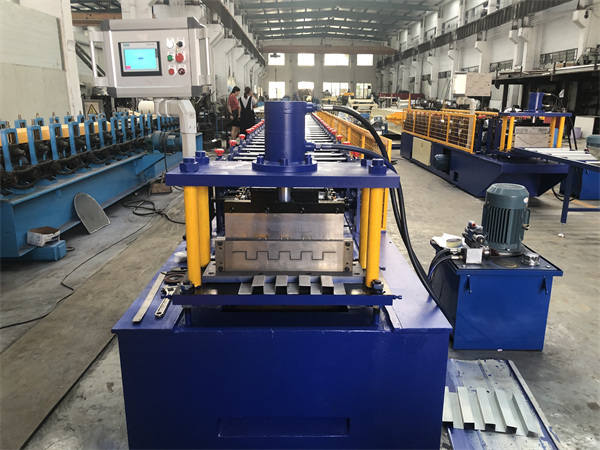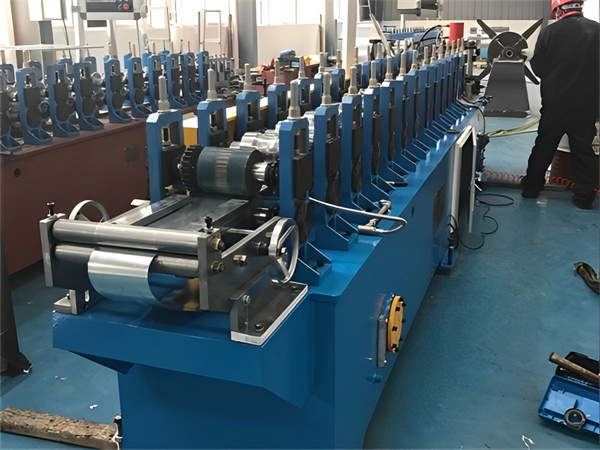1 परिचय
In the world of manufacturing and construction, efficiency and precision play a pivotal role in delivering high-quality products and structures. One technological marvel that has significantly contributed to this efficiency is the Mini Roll Forming Machine. In this article, we will delve into the intricacies of these machines, exploring their capabilities, applications, advantages, and future prospects.
2. What is a Mini Roll Forming Machine?
ए Mini Roll Forming Machine is a versatile manufacturing equipment that transforms metal coils into continuous profiles with consistent cross-sections. The process involves feeding metal coils into the machine, passing them through a series of rollers, which progressively shape the metal into the desired profile. The end product can be of varying lengths, making it ideal for applications that require long, continuous sections of metal with precise shapes and dimensions.
3. Advantages of Mini Roll Forming Machines
Mini Roll Forming Machines offer several advantages over traditional metal fabrication methods:
- Cost-Effective: Roll forming reduces material wastage and lowers labor costs due to its automated nature, making it a cost-effective manufacturing process.
- High Precision: The process ensures consistent dimensions and profiles, leading to higher precision and product quality.
- बहुमुखी प्रतिभा: Mini Roll Forming Machines can produce a wide range of profiles, making them adaptable to various industries and applications.
- Speed and Efficiency: With high production speeds and continuous operation, roll forming enhances productivity and efficiency.

4. Applications of Mini Roll Forming Machines
4.1 Roofing and Cladding
One of the most common applications of mini roll forming machines is in the roofing and cladding industry. These machines produce metal roofing panels and cladding sheets with excellent dimensional accuracy and aesthetic appeal.
4.2 Shelving and Racking Systems
Mini Roll Forming Machines are instrumental in the production of shelving and racking systems used in warehouses and storage facilities. These machines create robust and durable shelving components that can withstand heavy loads.
4.3 Automotive Industry
In the automotive sector, mini roll forming machines are employed to manufacture various automotive components, such as window channels, door frames, and bumper profiles.
4.4 Construction and Architecture
The construction industry extensively utilizes mini roll forming machines for producing studs, tracks, and other structural elements used in modern buildings.
5. How Does a Mini Roll Forming Machine Work?
The operation of a mini roll forming machine is based on a continuous and streamlined process. The primary steps involved are:
- Material Uncoiling: The process begins by uncoiling the metal strip or coil, which is then fed into the machine.
- Roll Forming Station: The metal strip passes through multiple pairs of rollers, each contributing to shaping the profile further.
- Cutting Mechanism: Once the desired length of the profile is achieved, the cutting mechanism severs the continuous profile into individual pieces.
- नियंत्रण प्रणाली: The entire process is managed and controlled by an automated system, ensuring precise and consistent production.
6. Key Components of a Mini Roll Forming Machine
6.1 Uncoiler
The uncoiler is responsible for holding and feeding the metal coil into the roll forming machine, ensuring a continuous supply of material.
6.2 Roll Forming Station
The roll forming station consists of a series of rollers, each with a specific profile, through which the metal strip passes successively, shaping it as desired.
6.3 Cutting Mechanism
The cutting mechanism is programmed to cut the continuous profile into individual pieces of the desired length.
6.4 Control System
The control system governs the entire operation, managing the machine’s speed, roller positions, and the cutting process.

7. Types of Profiles Produced by Mini Roll Forming Machines
7.1 C and Z Purlins
C and Z purlins are widely used in the construction industry to provide structural support to roofs and walls. Mini roll forming machines can efficiently produce these profiles in various sizes.
7.2 Metal Roofing Panels
Metal roofing panels are popular for their durability and weather resistance. Mini roll forming machines can create these panels with precision, ensuring a seamless fit.
7.3 Studs and Tracks
In drywall and partition systems, studs and tracks are essential components. Mini roll forming machines can produce these profiles quickly and accurately.
7.4 Window and Door Frames
Mini roll forming machines are capable of manufacturing customized window and door frames for residential and commercial applications.
8. Factors to Consider When Choosing a Mini Roll Forming Machine
8.1 Material Compatibility
Different mini roll forming machines are designed for specific materials. Manufacturers must consider the compatibility of the machine with the material they intend to use.
8.2 Production Speed
The production speed of the machine affects overall productivity. Choosing a machine with an optimal production rate can impact the efficiency of the entire manufacturing process.
8.3 Profile Complexity
Certain profiles require intricate shapes and design features. Manufacturers should assess the machine’s ability to produce such complex profiles.
8.4 Automation and Customization Options
Automation and customization features can streamline production and accommodate unique project requirements. Selecting a machine with these capabilities can be advantageous.
9. Maintenance and Troubleshooting Tips
Maintaining a mini roll forming machine is crucial for consistent performance and longevity. Regular cleaning, lubrication, and inspection are necessary to prevent downtime and ensure quality output. In case of any issues, timely troubleshooting and repairs can prevent further complications.
10. The Future of Mini Roll Forming Machines
The future of mini roll forming machines looks promising, driven by advancements in technology and the growing demand for efficient and sustainable manufacturing processes. Here are some key aspects that will shape the future of these machines:
10.1 Advancements in Automation
Automation will play a significant role in enhancing the capabilities of mini roll forming machines. Improved control systems and artificial intelligence will enable these machines to operate with higher precision and autonomy. Automated material handling, tool changeovers, and self-diagnostic capabilities will streamline production and reduce downtime.
10.2 Integration of IoT and Industry 4.0
The integration of Internet of Things (IoT) and Industry 4.0 concepts will lead to smart factories where mini roll forming machines are interconnected and communicate with each other and the central control system. This seamless integration will optimize production processes, minimize material wastage, and allow for real-time monitoring and analysis of machine performance.
10.3 Sustainability and Eco-Friendly Solutions
As the world becomes more environmentally conscious, mini roll forming machines will focus on sustainable practices and eco-friendly materials. The use of recycled metals and energy-efficient manufacturing processes will become more prevalent, making these machines even more appealing to environmentally conscious industries.
10.4 Customization and Flexibility
With increasing customer demands for unique and customized profiles, mini roll forming machines will evolve to offer higher levels of flexibility. Manufacturers will be able to create bespoke profiles without compromising on production speed or quality.
10.5 Integration of Additive Manufacturing
Additive manufacturing, also known as 3D printing, may find its way into the roll forming process. Integrating 3D printing technology with mini roll forming machines can add complex features and designs to profiles, opening up new possibilities for various industries.

11. निष्कर्ष
In conclusion, mini roll forming machines have revolutionized metal profiling, offering cost-effective, precise, and versatile solutions for various industries. Their applications span from roofing and cladding to automotive and construction sectors. With advancements in automation, IoT integration, sustainability, and customization, these machines are poised for a bright future in the manufacturing world.
As technology continues to advance, we can expect mini roll forming machines to become even more efficient, accommodating a broader range of profiles and materials. By embracing these innovations, manufacturers can stay ahead of the curve and leverage the capabilities of mini roll forming machines to their full potential.
पूछे जाने वाले प्रश्न
Q1: What is the difference between roll forming and press braking?
Roll forming and press braking are both metal forming processes, but they differ in how they shape metal. Roll forming uses a series of rollers to gradually bend and shape the metal into a continuous profile. Press braking, on the other hand, involves pressing the metal between a top and bottom die to create a specific bend or angle. Roll forming is ideal for producing long, continuous profiles, while press braking is better suited for making sharp bends and angles in shorter sections.
Q2: Can mini roll forming machines handle thick metal sheets?
Yes, mini roll forming machines can handle a range of metal thicknesses. The machine’s capacity will depend on its design and specifications. Some machines are specifically built for thinner materials, while others can handle thicker gauges. Manufacturers should select a machine that aligns with their desired material thickness and profile requirements.
Q3: Are mini roll forming machines easy to operate?
Mini roll forming machines are designed to be user-friendly and easy to operate. However, proper training and understanding of the machine’s functionalities are essential for efficient and safe operation. Manufacturers should provide adequate training to their operators to ensure smooth production and minimize the risk of accidents or errors.
Q4: What maintenance tasks are crucial for ensuring the longevity of a mini roll forming machine?
Regular maintenance is crucial for the longevity of a mini roll forming machine. Some essential maintenance tasks include cleaning and lubrication of rollers and components, inspecting for wear and tear, checking alignment, and ensuring the control system operates correctly. Routine maintenance will prevent unexpected breakdowns and ensure consistent product quality.
Q5: Can mini roll forming machines be used for stainless steel profiles?
Yes, mini roll forming machines can be used to produce stainless steel profiles. However, due to the differences in material properties, the machine’s design and specifications may need to be adapted to handle stainless steel effectively. Manufacturers should ensure that the machine they choose is compatible with the specific materials they intend to use.
